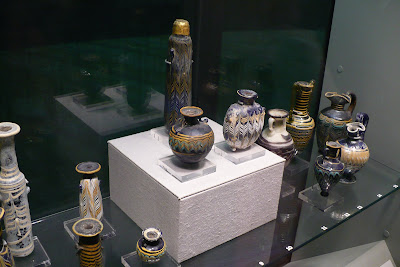
Photo by Christine Brandel
vessels in the Corning Museum of Glass
Okay, so this is not technically glass from the medieval period, but I did say at the outset that sometimes I would veer off into other periods, particularly the early ones. Okay, I sorta said that. But anyway.


The vessel in the back, on the far left side shows a good example of feathered lines. In the back middle vessel, and the front right vessel, the decoration is more like what is called 'festooning', ribbon-like designs with some curvature.
So! The Allaire Collection posted recently about one of their core-formed vessels, and that's what inspired my post today. I have a soft spot in my heart for core-forming. It was one of the first techniques I tried to replicate using period materials and processes, way back about seven or so years ago in the pursuit of projects as a member of the SCA. My experiments were not extremely successful, but they were educational, at least.
What is core-forming?
Basically, the technique of core-forming applies to making hollow vessels over a torch flame or furnace by using a shaped form on a stick. This is a particularly ancient technique, actually, since some of the best examples of it come from the Hellenistic and even the Egyptian periods. That is as far back as the 16th century BCE.
In the ancient period, the vessel forms were created using animal dung, straw, clay and water mixed to make a paste, which was then applied to a glassworking rod. The forms were dried completely, and then the shape was refined into what the glassworker wanted it to be. Glass was applied by either trailing the molten glass around the core, much as lampworking is done, or the cores could be dipped into a crucible furnace that holds a 'soup' of molten glass. In some cases, the theory is that layers of frit were applied and fired. Frit is basically crushed glass, and it can be mixed with water to form a paste, which could then be applied to the core.
This photo shows some core material remaining in the vessel:

Photo by Christine Brandel
Vessel in the Corning Museum of Glass
Once the glass was applied to the core, the whole thing would then be fired in the furnace until the glass was uniformly melted and cohesive. The vessel could be decorated, as so many were, with thin lines of glass wound around the vessel and then shaped using a sharp tool.
Common decorations were plain trailed lines, feathered lines, and shifted lines. As a lampworker, I can attest to the skill and steady hands required to place such thin lines around a shape in such a uniform manner, and to manipulate these lines without mangling the vessel or destroying the lines!
Feathered lines look like this:

Photo by Christine Brandel
Vessels in the Corning Museum of Glass
Once the piece was finished, the cores would be scraped out and the vessel was then ready for use. They were often used to hold kohl, for eye makeup, or for holding other oils, unguents, or small amounts of liquids.
Recently, the Corning Museum of Glass had a post on their blog about core vessels. The museum Explainers, volunteers who talk to visitors about the works in the museum, completed a workshop with hands-on experience in making the cores in the traditional manner, using traditional materials.
There is a Japanese glass artist who makes core-formed vessels. His work is evocative of the ancient vessels we see in museums today, but has a completely modern spin. Beautiful!
I hope you have enjoyed today's foray into ancient, pre-medieval period glassmaking! Below are some further references to explore on the subject, if you'd like more information.
*****************************************************************************
References:
Taylor, Mark, and Hill, David. Roman Glassmakers. Newsletter 7, January 2005. Web. 2 October 2011. <http://www.romanglassmakers.co.uk/nl7text.htm>
Kritzek, Mandy. "Dung-Core Vessel Making: Explained." Behind The Glass. Corning Museum of Glass. Web. 2 October 2011. <http://behindtheglass.cmog.org/2011/07/14/dung-core-vessel-making-explained/>
The J. Paul Getty Museum. Current Exhibitions: Molten Color. Web. 2 October 2011. < http://www.getty.edu/art/exhibitions/molten_color/>
Nicholson, P. T. and Shaw, I. (eds.) (2000) 'Ancient Egyptian Materials and Technology' Cambridge University Press. Ch.8, 'Glass'.







